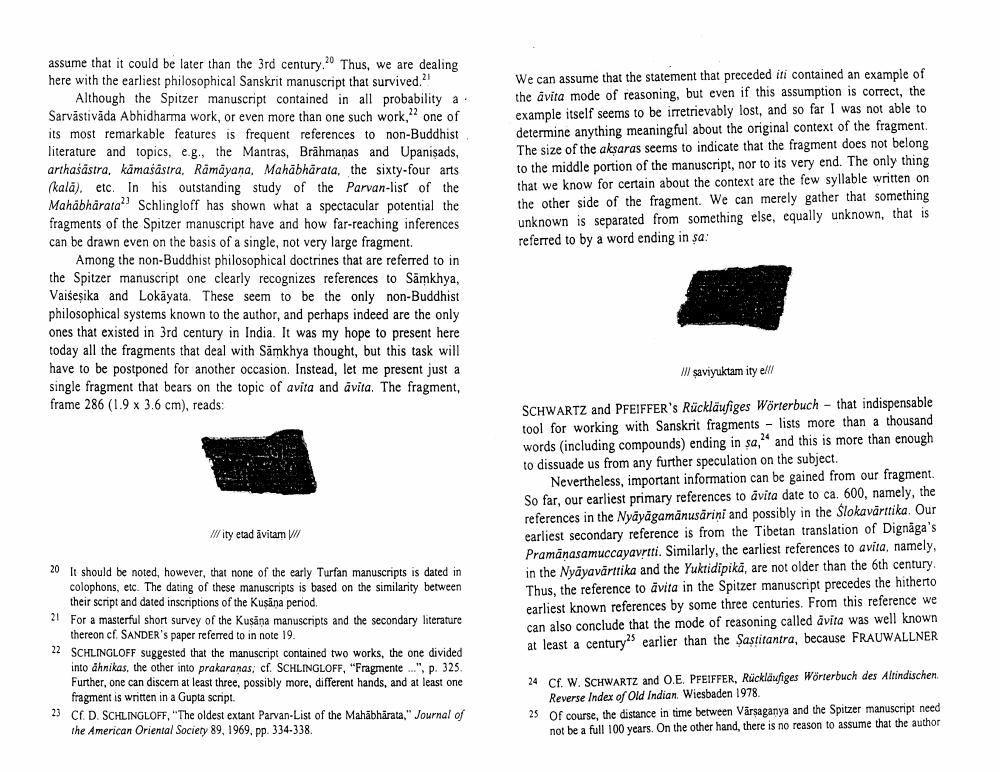Book Title: Avita And Avita Author(s): Eli Franco Publisher: Eli Franco View full book textPage 4
________________ assume that it could be later than the 3rd century20 Thus, we are dealing here with the earliest philosophical Sanskrit manuscript that survived." Although the Spitzer manuscript contained in all probability a. Sarvästivada Abhidharma work, or even more than one such work." one of its most remarkable features is frequent references to non-Buddhist literature and topics, e.g., the Mantras, Brahmanas and Upanişads, arthasastra, kamasastra, Ramayana, Mahabharata, the sixty-four arts (kalā). etc. In his outstanding study of the Parvan-list of the Mahabharata" Schlingloff has shown what a spectacular potential the fragments of the Spitzer manuscript have and how far-reaching inferences can be drawn even on the basis of a single, not very large fragment. Among the non-Buddhist philosophical doctrines that are referred to in the Spitzer manuscript one clearly recognizes references to Samkhya, Vaiseșika and Lokayata. These seem to be the only non-Buddhist philosophical systems known to the author, and perhaps indeed are the only ones that existed in 3rd century in India. It was my hope to present here today all the fragments that deal with Samkhya thought, but this task will have to be postponed for another occasion. Instead, let me present just a single fragment that bears on the topic of avita and avita. The fragment, frame 286 (1.9 x 3.6 cm), reads: We can assume that the statement that preceded iti contained an example of the avita mode of reasoning, but even if this assumption is correct, the example itself seems to be irretrievably lost, and so far I was not able to determine anything meaningful about the original context of the fragment. The size of the aksaras seems to indicate that the fragment does not belong to the middle portion of the manuscript, nor to its very end. The only thing that we know for certain about the context are the few syllable written on the other side of the fragment. We can merely gather that something unknown is separated from something else, equally unknown, that is referred to by a word ending in sa: II/ saviyuktam ity elll Illity etad āvitam SCHWARTZ and PFEIFFER's Rückläufiges Wörterbuch - that indispensable tool for working with Sanskrit fragments - lists more than a thousand words (including compounds) ending in sa, and this is more than enough to dissuade us from any further speculation on the subject. Nevertheless, important information can be gained from our fragment. So far, our earliest primary references to avita date to ca. 600, namely, the references in the Nyayagamănusarini and possibly in the Slokavårttika. Our earliest secondary reference is from the Tibetan translation of Dignåga's Pramanasamuccayavrtti. Similarly, the earliest references to avita, namely, in the Nyayavarttika and the Yuktidipika, are not older than the 6th century. Thus, the reference to avita in the Spitzer manuscript precedes the hitherto earliest known references by some three centuries. From this reference we can also conclude that the mode of reasoning called avita was well known at least a centurys earlier than the Sastitantra, because FRAUWALLNER 20 It should be noted, however, that none of the early Turfan manuscripts is dated in colophons, etc. The dating of these manuscripts is based on the similarity between their script and dated inscriptions of the Kusåna period 21 For a masterful short survey of the Kusana manuscripts and the secondary literature thereon cf. SANDER's paper referred to in note 19. 22 SCHLINGLOFF suggested that the manuscript contained two works, the one divided into ähnikas, the other into prakaranas; cf. SCHLINGLOFF, "Fragmente...". p. 325. Further, one can discem at least three, possibly more, different hands, and at least one fragment is written in a Gupta script. 23 C.D. SCHLINGLOFF, "The oldest extant Parvan-List of the Mahabharata," Journal of the American Oriental Society 89, 1969, pp. 334-338. 24 Cf. W. SCHWARTZ and O.E. PFEIFFER, Rückläufiges Wörterbuch des Altindischen Reverse Index of Old Indian Wiesbaden 1978. 25 Of course, the distance in time between Värsaganya and the Spitzer manuscript need not be a full 100 years. On the other hand, there is no reason to assume that the authorPage Navigation
1 2 3 4 5 6 7 8
